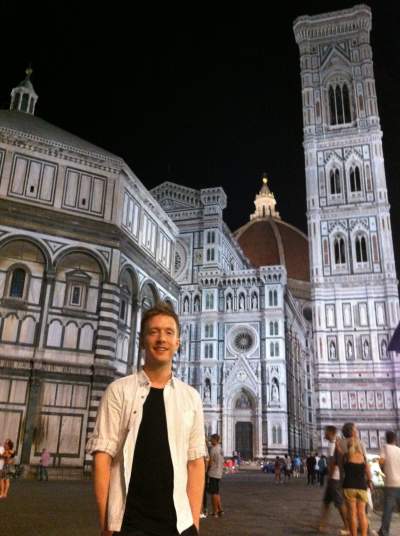
Welcome to my Italian Project! My goal with this project is to reach a conversational level in Italian by learning through the power of story. No grammar books, no textbooks, no lessons (at least initially) – just listening to and reading compelling content in Italian daily.
I created this page to give you an insight into every step of my learning journey.
You'll find details of each week of the project as it unfolded, as well as interviews with Italian language experts, my favourite resources, and my best tips for learning Italian!
By the way, if you're interested in this StoryLearning® method for reaching a conversational level in Italian, then I've created something special for you – Italian Uncovered.
It's my beginner course that will take you to intermediate level through stories, not rules. Find out more and claim your free 7-day trial of the method.
Table Of Contents
If you want to, you can skip ahead to the section that interests you, but I recommend you check out the project introduction first.
Week 3: Finding Your Dream Content
Week 5: Speaking Italian For The First Time
Week 6: What Do I Think Of My Speaking?
Week 7: An Extended Italian Conversation
Project Introduction: Olly Learns Italian…In London!
Welcome to the introduction of my new project to learn Italian!
In the last few years I’ve undertaken a number of language projects…
In each case, I’ve documented my journey for you, so you can draw inspiration for your own language learning.
But now it’s time for something new, and quite different.
This summer, I’m learning Italian.
But unlike previous projects…
- The project takes place here in London (not in Italy)
- I’ll be doing ZERO speaking for the first month
- And I’ll be doing it completely by myself
I want to demonstrate that anyone can learn a new language by themselves, in a short space of time, without picking up and moving to another country!
At the very end of the project, I’ll travel to Italy to be tested on my Italian. (There’s nowhere to hide!)
Read on for some more detail about the how and why of this project…
Why Am I Learning Italian?
Here in London, I meet Italians practically on a daily basis.
It doesn’t really feel like a “foreign language”, because it’s all around me on the streets of London.
I’ve been feeling for some time now that learning Italian would really enhance my life here, and so that’s the main aim of this project…
- The Aim: To learn to speak Italian, so I can have conversations with the people I meet – in Italian – and make life more fun!
There’s also a secondary aim to the project, which involves dispelling a myth!
There’s a stubborn belief among the general public that you can’t learn a new language as an adult.
“If you haven’t learned a language as a kid, there’s no hope!”
A recent study was widely circulated claiming that:
“If you want to achieve proficiency similar to that of a native speaker you should start learning before the age of 10.”
In the wake of this study, I began to notice “casual” language learners on Twitter using this study to justify their personal failure to learn a new language.
The danger is clear: Without the belief that learning a new language is possible, you’ll never succeed.
Of course, even if it is impossible to reach a genuine “native level” in a foreign language as an adult (i.e. you’re indistinguishable from a native speaker), that should never be your goal in the first place!
If the point of learning a new language is to communicate with and enjoy the company of the people you meet, you can achieve that with far less than native-level skills.
Indeed, you can radically transform your life with even an intermediate level in a foreign language.
And that’s what I’m seeking to demonstrate with this project.
(If you’ve been following my stuff for a while, you already know this. But I’m hoping to reach new audiences with this project.)
How Far Will l Get In Italian?
My aim for the project is to be able to have natural conversations with Italians here in London.
That’s my measurement for success.
I’m not particularly worried about the exact CEFR level I’ll reach in this time, but I’ll aspire to a B2 level, given my language background, and knowledge of other Romance languages (Es, Fr, Pt).
Goal setting is a funny thing in language learning. I’ve always believed it’s important, but I’ve never really known how to set goals.
Why?
Because you can’t control the level you’ll reach in a language.
But you CAN control the actions you take that might help you reach that level in the language.
So, instead of focusing on the outcome, I’m focusing on the process.
Let’s talk about the process…
What’s The Plan?
My views on language learning have been changing quite a bit in recent times.
After running into various challenges in the difficult languages I’ve learned recently, I’ve started to believe that the key to reaching those higher levels is to focus much more on input (reading and listening) than on traditional study methods, such as learning grammar, memorising vocabulary etc.
It’s the theory espoused by Stephen Krashen, as you can find in my interview with him here.
The particular kind of input I’ve found most powerful of all is stories, for 16 different reasons.
I base all my language material and courses on story-based methods, and the feedback has been wildly popular, as students have been reporting huge gains in their language levels.
(Hardly surprising, when traditional language learning methods focus so heavily on deliberate study. As soon as you start getting hours of quality input, through stories, you’re catching up the kind of thing you should have been doing for years anyway!)
Here’s a discussion with Steve Kaufmann where we go into this methodology in more depth…
Anyway…
With my Italian project, I will give a demonstration of how you can learn a new language from scratch using an input-based method built on stories.
I’ll be documenting the whole thing in videos and blog posts.
Here’s roughly what to expect…
Documenting The Learning Process
MONTH 1
- Massive input through stories and other compelling material (short stories, Conversations, audiobooks, podcasts)
- No speaking
- 2 hours per day of study, plus DEAD TIME
Note: After one month, you’ll see a video of my very first conversation in Italian. It’ll be interesting to see how well I can speak after a whole month of pure input!
MONTH 2
- Lots of speaking
- More and more input
MONTH 3
- Start to take lessons from professional tutors to help me notice gaps and refine my speaking
- Continue with the input and speaking
At the end of the process, I’ll be travelling to Italy to be tested on my level.
Since I don’t have a particular target level of Italian in mind, the point of getting tested is two-fold:
- It will make for a cool video!
- It will help to quantify what I’ve done
One last thing.
As I’m placing a lot of emphasis on the input-based methodology I’m using to learn, I want to try and quantify my learning as much as possible.
- How many hours did I study?
- How many words did I learn?
- How many hours of listening did I do?
To help with this, I’m going to be doing all my study using LingQ. I’ll still be choosing my own material, but by doing all my reading and listening on the LingQ platform, I’ll be able to see all the numbers as I go.
At the end of the project, this will help to answer some of the hard questions around how others can replicate what I’m doing in their own language learning.
WEEK 1: All About Input
Welcome to my first video update on my Italian project!
In this post, I’ll explain everything I’ve been doing during the first seven days of the project, including:
- How I’ve been learning
- The materials I’ve been using
- Challenges I’ve been facing
Week 1 Statistics
I’ve been doing as much of my study as possible on LingQ, in order to track my statistics during the project. However, as you’ll see later, I have been doing quite a bit of Italian away from the platform, so the numbers you see above are conservative.
Note: You can follow my stats live on my LingQ profile.
How Have I Been Learning?

The aim of the first month is to get as much input as possible. So if I had to characterise this first week of the project, it would be with the words “massive input”.
I’ve been focusing on spending as much time as possible listening and reading to Italian – aiming for 3 hours of study a day (with one day off – important!).
Here’s what my day looks like:
CORE STUDY TIME
First thing in the morning, during my 1-hour “core study time”, I’ve been doing focused, concentrated work. This means listening and reading along at the same time.
During this time, the activity I’m doing apart from the listening/reading is stopping to look up vocabulary I don’t understand. For the first few days, I was doing this quite a lot. As the week went on, and I realised I was starting to understand a fair bit, I started doing that less and less.
It’s not ideal to always be starting and stopping, so what I try to do is listen to something a few times without the text, just to give my brain the chance to stretch, and understand as much as possible by itself. I find that when I then go in and add the text, a lot of things click and I get some “aha moments”.
REST OF THE DAY
After my morning session, the rest of the day is a mix. Sometimes, I’ve done all three hours with audio and text together, but more often than not I’m out and about, so I get the extra two hours while walking, commuting, in the gym etc… and in this case, I’m just listening. (No reading.)
What Materials Have I Been Using?
As a beginner, I’ve had to use simplified material:
- LingQ’s Italian mini stories (set of 20)
- My books of short stories for beginners (Vol I, Vol II)
- Podcast Italiano (especially the interviews)
- Italiano Automatico
(I either found or imported this material into LingQ in order to track the study time.)
After the first 3-4 days, I started to experiment with authentic material, to see if I could handle real Italian.
My starting point was to look for stuff that I was really interested in. It’s the notion of compelling input.
Here’s what I found:
- Breaking Italy – a daily infotainment YouTube show
- EfficaceMente – a cool YouTube channel on personal development
- Introduzione al Growth Hacking – A free course on Udemy about Growth Hacking.
Needless to say, this stuff was much harder!
However, because I’m really interested in all the content, I found myself drawn to watching it. As a result, I spent more time with Italian.
Over time, I think this will become a key source of input, and hopefully, this content will lead me to more similar stuff on the internet.
Thoughts On My Progress
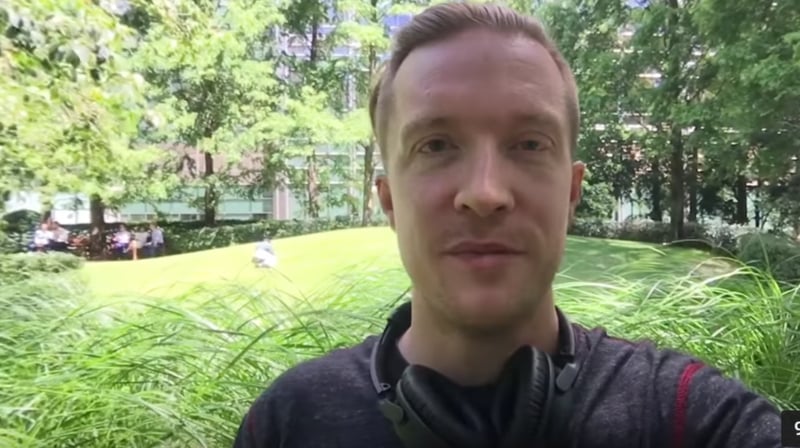
It’s difficult to do lots of listening!
It really is.
I found myself getting tired and losing concentration a lot, especially at first. You’ve also got to be strict with yourself about using all your dead time throughout the day for listening to Italian.
However, by the same token, it’s amazing just how much input you can get over the course of your day, if you’re strict about using your dead time well, and not just heading mindlessly to your favourite YouTube channel, website or podcast in English. (I’m breaking a lot of habits with this project!)
My progress has been fast. While in the first few days I didn’t understand all that much, by the end of the week, my brain seemed to have adapted, and I was following along with intermediate content quite comfortably.
Of course, my aim is ultimately to speak. So it doesn’t really matter how much I understand. I suspect it’ll be a VERY different story when I eventually open my mouth and have to speak.
If Spanish or French comes out of my mouth, that won’t cut the mustard!
I’ve also been thinking about just how different the reading and listening skills are.
With listening, you can gloss over quite a lot of detail, providing you understand the gist of what you’re listening to.
It’s when you read along at the same time that you really get to notice key details of the language – pronunciation in relation to spelling, grammatical structures, and so on.
Looking forward, I suspect that when I come to speak, reading (more than listening) will become the most impactful activity, because it will draw my attention more to accuracy in Italian.
A Note On Grammar
During this whole week, I’ve had tonnes and tonnes of questions about grammar…
Things I’ve seen in my texts that didn’t make sense, or that I just wanted to know more about.
However, I haven’t stopped to look up ANY grammar more than a handful of times. Three times perhaps.
Why?
Because I realise that the huge opportunity I have from this month of input, is to spend as much time with Italian as possible. As soon as I start to study grammar, it will totally change the way I study, taking time away from listening and reading, and have a big knock-on effect.
It hasn’t been easy to resist looking at grammar though. I feel a real desire to. I’ve just been trying to let the experiment run its course and stick with the input!
In month two, when I start to speak, I’ll undoubtedly have to start to look at the grammar of Italian in a lot more detail.
So far, though, I’ve just been enjoying the language.
And I must say, I’ve been having a great time!
WEEK 2: An Avalanche Of Input
Welcome to week two of my Italian project!
In this post, I’ll explain everything I’ve been doing during the second week of this project to learn Italian here in London.
Week 2 Statistics
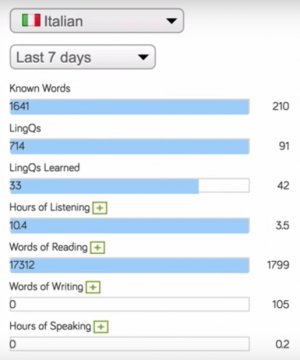
Here are my stats from LingQ, which I've been using to track all my listening and reading activity.
The key figure for week 2 is 10.4 hours of listening.
That's actually a little down on the first week, but still averaging about 2 hours per day (weekdays).
I had a few events last week that robbed me of my concentration a bit, so I'll be sure to refocus next week, and aim to hit 3 hours a day. I often find that it's smart to aim high so that even if you don't quite reach your goal, you still achieve more than you would if you'd aimed more modestly.
[Note: To follow my stats live throughout this project, check out my LingQ profile.]
How Have I Been Learning?
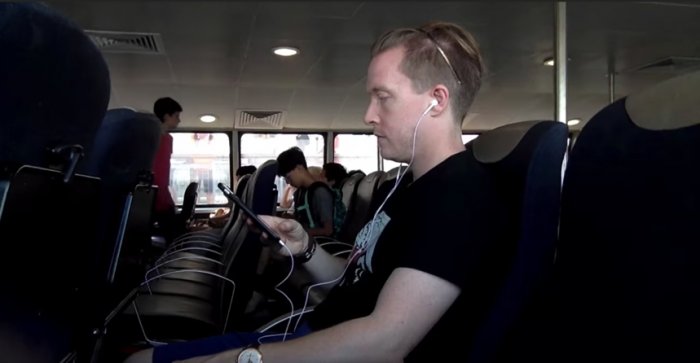
As you’ll remember, the aim of the first month is to get as much input as possible.
And this second week of Italian for me can best be described as an “avalanche of input”.
Much like week 1, I've been listening to as much stuff as I can get my hands on (see below), filling up the various free hours of my day with listening.
Since I did a lot of my study this week while out and about, I did mostly listening without reading. This has been great, but it's also made me aware of a potential danger, which I'll talk about a bit later.
It's still surprising to me just how difficult it is to fit in 2-3 hours a day of listening.
I mean… I have the time. Often hours a day of time spent walking, on the train, on the bus etc…
But the thing I find hard is the intentionality of saying to myself:
“Right, when I sit down, I'm not checking Whatsapp, I'm not checking my emails, I'm not listening to any of the 100s of English podcasts that I want to listen to…
…I'm just going to listen to Italian!”
It's a willpower exercise as much as anything else.
And that leads me to the first main difference between week 1 and week 2…
The Search For Compelling Content
In week 1, I was on a tour of beginner/low-intermediate material… of which there is a tonne!
But in week 2, I've already discovered that I can understand quite a lot of the Italian I hear.
So, in order to stay motivated for the 2-3 hours a day I'm spending listening to Italian, I've been trying extremely hard to track down material that could be described as compelling input.
In other words, material that I'm deeply interested in.
And there's a difficult intersection to navigate here…
Namely, the only content that is interesting to me at this point is real, authentic, native-speaker content. But the trouble is that much of that kind of content is too hard for me right now!
So I'm faced with that dilemma of:
- Listen to stuff that is “comprehensible” but not so interesting, or
- Listen to authentic stuff that is too hard
Now, what we know about language learning is that you acquire language when you understand what you read or hear.
The key word there being “understand”.
And so, at this stage, I'm still tending to spend my core study time focused on comprehensible input, which basically means material intended for learners.
Then, later, when I'm out and about, I'm listening to more authentic stuff that grabs my interest.
Luckily, I've also been finding some really interesting authentic material that isn't tooo hard to understand.
I'll share that with you below if you like 🙂
What's for sure is that I've been spending a frustrating amount of time actually searching for that material which I like. So one thing I've been trying to do is, once I've found a content provider I like, stop searching for more, and absorb everything I can from that person!
Anyway, to summarise, here's what my day looks like:
CORE STUDY TIME
I do an hour of listening and reading first thing in the morning when I wake up.
I'm sticking to “comprehensible input” (i.e. still learner material) that comes with text.
REST OF THE DAY
For the rest of the day, I use a mix of the learner material from the morning and authentic material that I'm interested in.
This is the bulk of the day… taking up 1-2 hours of solid listening.
What Materials Have I Been Using?
I'll divide this into two sections – the “learner material” I've been using in the morning, and the “authentic material” I've been using for the rest of the day.
I'm only going to include stuff here that I used and thought was really good.
Learner Material
- Conversations – This is my material to upgrade your listening skills through dialogue-based stories. I found that it was absolutely perfect for me this week, and at just the right level. I lapped this up over the course of the week.
- Conversazioni Reali in Italiano – This is an amazing (paid) resource that Alberto from Italiano Automatico was kind enough to share with me. It's a collection of spontaneous conversations in Italian between Alberto and his friends, which is fantastic for getting used to natural Italian. There are transcripts, translations, lesson notes, and much more. I'd still classify this as learner material since the topics are carefully controlled, but there's so much natural language that I was super excited to
- Podcast Italiano – I love this podcast, and I never get bored of listening to new episodes. What I most like about Podcast Italiano is that Davide is a smart guy, and tackles serious topics, which really helps to keep me engaged in the material. Highly recommended. (Oh, and there are transcripts.)
It's worth saying that many readers have been sending me through their favourite learner resources for Italian, and I've tried a lot of them out. However, nothing really worked for me. It was either too easy, too short (surprisingly common), or just not very interesting.
Authentic Material
Here's the native content I've been listening to that I've absolutely loved. It goes without saying that this stuff matches my personal interests, so you may well hate them.
At the very least, it should give you some inspiration to find other material for yourself.
- Veleno – Wow. Have you ever listened to S-Town or Serial? Well, Veleno is a “podcast serial” by La Repubblica, told over seven episodes. Much like This American Life, the production quality is exceptionally high. Episodes are 30-40 minutes long, with some challenging language, but I didn't care. Just goes to show the power of compelling input! Warning: The subject matter is extremely dark. As dark as it comes. However, the quality of the storytelling is such that you'll be gripped from the start… if you can stomach it!
- EfficaceMente – a cool YouTube channel on personal development that I mentioned last week. I've also been reading the guy's blog, which is much more colloquial than the YouTube channel and a great source of reading material.
- Italo-Digitali – An Italian podcast about online business, created by an Italian and Canadian couple. I don't know why I don't find this harder than I do… but I find it all pretty easy to follow along, perhaps because I'm so familiar with the subject matter. I've been listening to this in the gym in the morning, which often gives me an extra hour of morning listening right off the bat.
- Dario Vignali Podcast – Another business podcast, by a marketer called Dario who speak fast Italian! This one is much harder to understand, but again, because I'm interested in the subject matter, I push myself to follow along!
- EuroNews – News in different languages.
- The Consequences of Love – An Italian movie on Amazon Prime. Not so much dialogue, actually, but it's my first foray into Italian movies during this project!
Needless to say, this stuff was all much harder than the learner material!
However, because I’m really interested in all the content, I found myself drawn to watching it. As a result, I spent more time with Italian.
Thoughts On Listening vs Reading

One last thing I've been pondering this week is the relationship between reading and listening, and how these two skills are contributing to my progress.
I've been spending the majority of my time listening… not reading.
And I've been noticing that, while my comprehension is already through-the-roof (after two weeks of solid input), I don't think I'd be able to say all that much at this point.
At least not with much accuracy.
You see, when you listen, you don't have to care about adjective endings, verb conjugations, prepositions, etc… because that detail rarely matters for comprehension.
But when you come to speak, you've got to get that stuff right.
A couple of times over the last week, I've tried reading without any audio.
And it's much harder.
However, I find I notice a lot more detail when I'm reading.
So I have a hypothesis right now that, given my listening is already quite strong, it's reading that's going to help me with my own accuracy when I come to speak.
I might try that out next week and see what happens.
Anyway, I'm still having a great time learning Italian.
WEEK 3 – Finding Your Dream Content
When I was a kid, I remember doing something silly (but rather fun) on sunny days.
I would go outside with a magnifying glass and hold it in direct sunlight over a leaf.
The aim is to get the leaf to catch light.
Of course, the trick to getting the leaf to burst into flames is to move the magnifying glass up and down until you find just the right distance from the leaf.
When you find that perfect distance, the sun's rays are focused into a powerful “laser” that contains enough heat to cause combustion.
Did you ever try something similar as a kid?
In case you're wondering where I'm going with this, week three of my Italian project has felt exactly like this magnifying glass experiment.
Let me tell you why…
The Power Of Compelling Input

I spent week two of the project experimenting with a huge amount of different content, from Italian podcasts, to Italian movies, to news.
But during week three, I've cut most of that out and spent most of my Italian time focused on only 2-3 resources.
Why?
Well, here's the thing…
I didn't choose these 2-3 resources because they're “the most useful”.
Nor because they're at “just the right level”.
Nope.
The reason I've been using these materials so heavily is that I'm genuinely addicted to them!
- I understand them (they're comprehensible)
- I'm deeply interested in the subject matter (they're compelling)
…and the fact that they're authentic (intended for native Italian speakers) is a bonus!
These resources are:
- EfficaceMente – a personal development blog
- Italo-Digitali – a podcast on online business
- Veleno – a podcast series from la Repubblica.it telling a horrific story from 1990s Italy
You might look at this list and think… “Eh?”
And, of course, it doesn't really matter what these materials are, and whether they sound interesting to you or anyone else…
The point is that this material represents stuff that I wake up in the morning and think: “You know what? I really fancy reading/listening to that right now…”
(The key word in the last sentence being “I”!)
When I go to the gym in the morning, instead of my favourite English-language podcasts that I tend to listen to (…and I can tell you what they are if you're interested), I now want to turn on the Italian material… giving me an extra hour of listening time right there.
I really can't put into words what it feels like to have found material that really excites me in Italian… and so soon into my project.
In just the same way that moving the magnifying glass to the correct height focuses the rays of the sun and causes the leaf to burst into flames, finding the right combination of material that is both comprehensible and compelling, causes a chain reaction in my life that leads me to consume many more hours of Italian content than I otherwise would.
And do it with a degree of fascination and motivation that makes learning Italian more fun, rewarding, educational, and – not least – effective.
If there's one lesson I draw from this week, it's this:
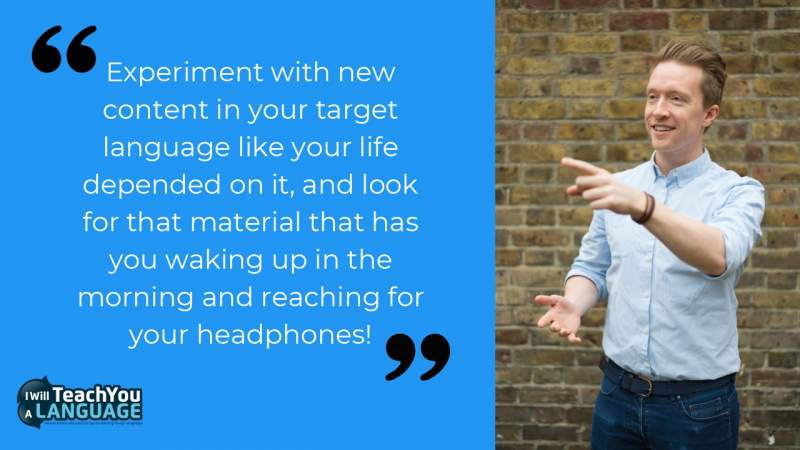
Returning To The “Opera” Angle
In my conversation with Gabe Wyner, we discussed the potential for using opera to learn Italian.
Truth be told, I've kind of avoided opera since this project began, I think because I didn't really see it as efficient content, in terms of the volume and usefulness of language (singing just one sentence can take over a minute in opera).
However, as the initial excitement of my project has started to die down, I've found myself craving to spend my “study” time with stuff I really like.
And so I decided to reconnect with opera this week, in as meaningful a way as I could…
So I went to see La Boheme at the Royal Opera House in Covent Garden.

Check out the video for more about that, but suffice it to say that it was the best possible way to spend a Saturday afternoon, while getting in a few hours' listening to Italian!
I suspect I'm opening up a new chapter in my Italian here, but I'll save that for another day.
Strategy Change – More Reading!
A silly question of course…
But something I've been thinking about in relation to my own progress this week.
I'd been wondering whether all the listening I'd been doing had been preventing me from focusing enough on the detail of the language:
- Verb endings in Italian
- Prepositions in Italian
- Double consonants
- Etc etc
…my concern being that I'm getting quite good at understanding Italian, but not so good at using Italian.
To be expected, perhaps, since the focus of this month has been on input.
But as an experiment, I decided to spend my core study time in the morning only reading — with no listening.
And wow… does it make a difference!!!
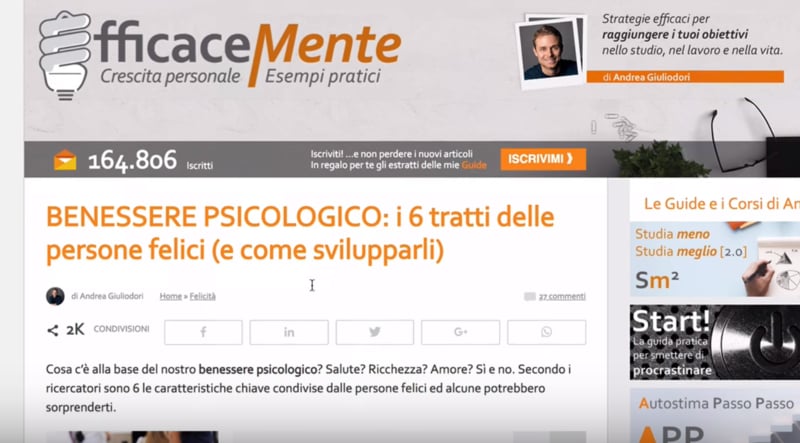
At least for where my Italian is at right now, it's been super-beneficial. Which is to say… reading is far harder than listening! (For me, at this stage in my Italian.)
Without the audio playing, leading you automatically by the hand to the end of the sentence, you're left to decipher every word on the page by yourself, responsible for reading to the end of the sentence under your own steam.
The temptation is to examine the grammar being used more than you might otherwise, if audio was playing, because you're responsible for your own pace in the reading.
To put it simply: You have to force yourself to keep reading – and not re-read ad infinitum – in spite of ambiguity, whereas with listening you simply have to keep your hand away from the pause button and you effortlessly progress through the material.
What this comes down to, I think, is a question of balance.
I've been doing a lot of listening. (And I mean a LOT… 12+ hs per week.)
So it's only reasonable that I should balance that out with some reading.
Week Three Conclusion
An unexpected week, but a very happy turn of events.
I feel more connected to and involved in Italian than in previous weeks and I'm excited to see where it leads.
Here are my stats from LingQ from the last week, for what they're worth.
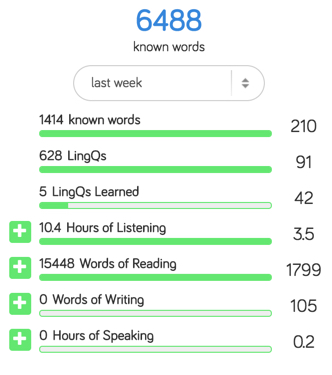
Since I've been doing less listening in the mornings, “hours of listening” are down from last week, but still pretty good at 10.4.
1,400 new “known words” a week is consistent with the previous week, so that seems to be an emerging pattern.
The big point I'd make here, though, is that reading is much, much slower than listening, so that's going to affect the stats accordingly.
Alright… that's it for now…
My first speaking session is on the horizon, and I must say… I can't wait for it!
I'm going crazy over here – not being able to speak.
But I asked for it… 🙂
WEEK 4 – Update Q&A
Today is the end of month 1 of my project to learn Italian.
For the last 4 weeks, I've been doing nothing but reading and listening in Italian.
No speaking.
No grammar.
No textbooks.
Niente.
And in the next section , you'll see the results of this, as I have my first conversations in Italian, and show you the results on video.
For me, there's one simple question:
Can you learn to speak a new language through input alone?
There's nowhere to hide! See the next entry for the results.
In the meantime…
Your Questions Answered
This week, I didn't do anything particularly different or interesting in my learning to warrant an entire video.
So instead, I opened the floor to my Facebook Community for questions about the project.
My answers are all in the video above, and here are the questions in the order they appear in the video, in case you'd like to skip ahead:
- 1:54 Chenelle & Daf – Has your knowledge of Spanish helped in your learning process or has it interfered?
- 3:41 Saul – Is this method more effective than the previous methods you have tried. What are your thought on this method and how would you complement it?
- 5:45 Fit & Michal – How much of the content you’re reading and listening to do you understand as a beginner? Do you often have to look for words and read grammar rules? Ever since you started, have you regretted not going through some basics?
- 8:28 Clayton – Is it becoming easier over time to put in the time or harder?
- 9:48 Charlotte – What if you only had the amount of time daily to learn, like the average person does. Sometimes lucky to have 10 or 15 minutes. What would your strategy be and how far would you be?
- 11:26 Pam – Have you been using your own resources, short stories, Conversations, etc., as a learning tool? If yes how would you evaluate them now that you’re approaching from a different perspective?
- 14:19 Neil – With using LingQ as a key tool, did you rely mostly on the existing content or did you spend the time to upload other content that interested you (or did you not bother to use LingQ for your own content)?
- 15:45 Linda -When you start a new language, how do you know where to find good material that won't just frustrate you
WEEK 5 – Speaking Italian For The First Time
Today is the day you've been waiting for!
After an entire month learning Italian, I finally opened my mouth and spoke Italian for the first time.
In today's video, you'll see the results!
What you'll see is a compilation of five conversations in Italian – one conversation from every day last week, presented in chronological order.
(Huge thanks to Martina for putting up with me for an entire week!)
I'm going to resist the temptation to comment on how I think I did … I'll save that for next week!
Instead, I'll just suggest you consider two things as you watch:
- How was my Italian on day 1?
- How did my Italian develop over the course of the week?
Speaking Italian For The First Time
To be honest, I was equally curious to see what would happen.
After all, the study method I used was totally new for me – a strict “input only” diet.
In other words, I spent the entire first month listening and reading to Italian:
- I didn't take any lessons
- I didn't use any textbooks
- I didn't study any grammar
- And I didn't speak a word of Italian!
So, the obvious question was…
Would I actually be able to speak the language? Or would I simply stumble horribly over every word?
Judge for yourself…
And see you next week for more — after all, there are still two months of the project left, including a trip to Italy to be officially tested!
WEEK 6 – What Do I Think Of My Speaking?
Phew!
Last week was a bit of a marathon, speaking Italian every day … and recording it!
I also admit it was really difficult to choose which clips to include. Obviously, in 5 hours of video, there's a lot to choose from.
Good bits, bad bits, and everything in-between.
So I chose a mix! And there were many comments saying “it was a relief to see you struggling!” – and I was pleased about that, because I chose to include the “struggling” bits precisely for that reason.
By the same token, I felt that there was a real improvement over the course of the week, and so for days 4 and 5, I chose clips that were among the best…clips that I felt represented that improvement.
Anyhoo…
That doesn't matter so much, because the true state of my Italian will become clear over the next 2 months … there's nowhere to hide!
So How Did I Do?
This week, then, I'll give you my thoughts on how I did in my speaking last week, after one month of silence.
Here's what I discuss in the video:
- 1:01 My thoughts on the first week
- 2:12 What Martina thought about my Italian
- 2:39 Rating my fluency and accuracy
- 3:45 What happened on day 3?
- 5:04 The one unexpected result of the input method
- 7:12 My biggest mistakes in Italian
- 9:50 The 3 things I’m focusing on moving forward
WEEK 7 – An Extended Italian Conversation
Today marks 7 weeks since I started this project to learn Italian.
And so far, I've given you a pretty comprehensive overview of all aspects of my learning.
Hopefully, you've been enjoying it!
But I'm also conscious that while giving an overview of my learning process and how I'm getting on is helpful, it might also be useful to see exactly what I do when I practice Italian – no commentary, no reflections… just plain unfiltered Italian practice.
Here's what one reader emailed me recently:
“Olly, the speaking clips you've shared in recent weeks have been great! It's fascinating to see your progress day by day over the course of a week.
But I'd also love to see a longer clip so I can better understand exactly how you structure your speaking sessions.”.
So for my latest update, I decided to do something different…
This week, you’ve got an extended video of me speaking Italian, so you can see:
- a) My progress, 2 weeks on from my first conversations
- b) Something MORE than the 2-minute clips I showed you last time
My partner in crime is Stefano, who, as you can see from the video, is a fantastic speaking partner.
Here are Stefano's details – please look him up!
Enjoy!
What Have I Been Up To?
Many of you have been asking about how I’ve been studying for the last couple of weeks:
- speaking vs reading
- tackling verbs
- remembering prepositions, etc.
And I’ll talk about that in detail soon enough… probably next week.
Can't give it all away just yet 🙂
The last week or so has been tough – one week of sickness and another of travel.
But in spite of this, I’ve managed to keep up my morning study routine, getting in a minimum of 1-hour listening & reading in Italian each day.
And I'm chuffed with myself for keeping this up.
Like I always say… consistency trumps all else in language learning!
Oh yes… I’ve also got a firm favourite new resource!
An Italian resource that's so good I've literally stopped listening to anything else.
I'll tell you about that in the next entry. I’ll also tell you the three exact things I’ve been doing every day, apart from speaking, to keep improving my Italian… so make sure to continue reading.
WEEK 8 – The Honeymoon Is Over!
The “Honeymoon Period” is something I bet you’re familiar with.
It’s a phenomenon that’s usually used to talk about newlyweds.
But here, I’m talking about a different kind of love…
Love with a new language!
In language learning, the “Honeymoon Period” is that feeling of elation in the very beginning, where you experience the joy of communicating in a new language for the first time.
It’s almost like an out-of-body experience where you find yourself using new words, in a weird order, with unfamiliar sounds…
And yet somehow managing to communicate with the person in front of you!
It’s as if you’ve performed a superhuman feat by transforming into a new person, with a new brain, and a new way of looking at the world…
And it feels great!
Soon, however, you come crashing back to Earth with a thud.
The End Of The Honeymoon
The magical “Honeymoon” phase is over.
The magic and joy has been replaced by tiredness and frustration.
The novelty of your first speaking experiences has worn of.
Instead, your new language turns its head, looks at you, sticks one finger up, and says with a smirk: “Hah! You thought you knew me… but actually you know NOTHING!!! Mwuhahahaha….”
The language then turns on its heels, and runs off at 100mph.
You begin a long, weary journey of trying to catch up, in the hope of one day getting the better of him.
Sound familiar?
It does? Thought so.
In fact, I’ve just had an ugly reminder of how this feels in my Italian.
A Psychological Battle… With Myself

The “Honeymoon Period” in a new language ends abruptly and predictably shortly after you begin studying.
For most people it takes around 2-3 months to happen.
But in my case it happened after about 5 weeks.
In fact, it happened immediately after my first week of speaking.
Funny…
I was delighted after my first week of speaking Italian with Martina.
The long month of input had been incredibly effective, and I had proven to myself that I was able to communicate and enjoy a conversation in Italian.
That felt great!
But as I moved into the second week, my mindset was turned upside down.
At first, I was impressed by how many words I knew…
But I quickly became frustrated by all the words I didn’t know.
(And the ratio was clearly 99:1!!!)
At first, I was pleased to see how my grammar was making sense, and getting the job done…
But I quickly became aware of all the mistakes, and my complete lack of awareness of Italian verb tenses, verb conjugations, use of the subjunctive, etc. etc.
At first, I was happy to hear that I had a “good accent” when I spoke Italian.
But I quickly got irritated at my Spanish accent that was clearly sneaking through.
You get the picture.
Heightened Awareness in Your New Language
I’m sure you know what this feels like, but have you ever thought about what causes it?
I think many people make the assumption that the language is “getting harder” at this new stage.
But that’s not it.
The language was always just as hard. Nothing’s changed.
It’s you who’s changed!
And what has changed specifically is a thing called “heightened awareness”.
With heightened awareness, you’re far more aware of the many elements of the language than you used to be.
In fact, the end of the Honeymoon Period is a fantastic sign of progress!
But it sure doesn’t feel like it.
It’s one of many examples of how language learning is a psychological battle you fight with yourself.
Anyway, in the last few weeks of my Italian project, I’ve experienced a whirlwind…
- The Honeymoon Period has ended
- I’ve been through the whole range of emotions that come with that
- And I’ve emerged the other side, far more zen than I was before
It might sound like a lot to happen in only 2-3 weeks.
But I suspect that the intensity I’ve been approaching this project with has meant I’ve experienced what might be 6-12 months of study in normal circumstances… in a few short weeks!
The Solution: Get Out Of Your Own Way
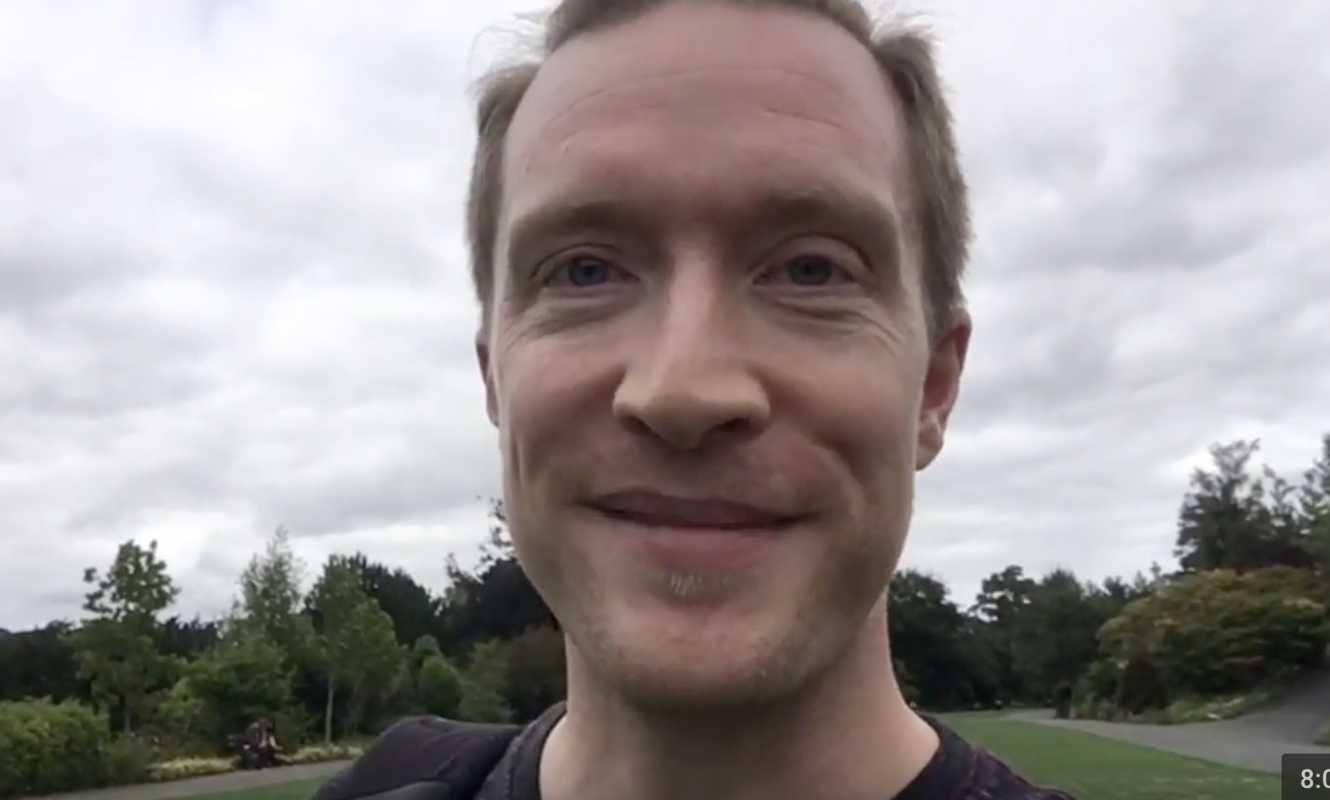
I just said that I emerged on the other side.
But what does that mean?
This has been interesting, and may also be a learning point for you if you’re currently struggling through a plateau, or a loss of motivation.
You see, there were a whole bunch of things I was unhappy with…
- My range of vocabulary
- My accuracy of grammar
- My accent and pronunciation
These are, of course, three BIG things.
The kind of things that entire courses and curriculums are often devoted to “solving”.
But in my case, they all resolved themselves naturally!
Take grammar for example.
To sort out my verb conjugations and tenses, I could have gone out and bought a bunch of grammar books and spent the next 6 months working through them until I “know Italian grammar”.
(Most people do just that.)
But instead, I just focused on the basics of my “input-based” method.
- I maintained my 1-2 hours per day of comprehensible input
- I continued experimenting with new content to find the most compelling content possible
- I spoke Italian for 1-2 hours every day
And sure enough, as I looked back on my week 7 speaking video from last week, I noticed a huge improvement in the accuracy of my verb tenses and conjugations.
(Note: I did do a couple of specific exercises to work on my grammar – more info on that in the video.)
Now, it would be very difficult to draw an exact connection between the activities I did and the improvement in my grammar.
Most likely it’s a combination of everything.
But the clear lesson here can be summarised by a classic quote, often attributed to Mark Twain:
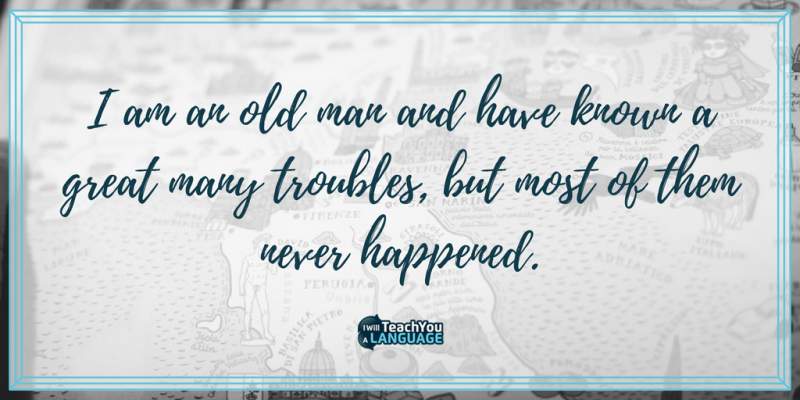
Point is… so many things we worry about in language learning work themselves out naturally over time.
All you have to do is focus on the basics:
- A lot of comprehensible input (so you can understand what’s going on)
- …on compelling topics (so you’re motivated to keep reading/listening)
- A lot of meaningful speaking practice (so you can learn to recall and produce what you learn in conversation)
Those are the basics as far as I’m concerned.
And it seems to be working so far!
So, that’s it for this week.
There’s a lot more that I didn’t mention here, but it’s all in the video, so please watch that if you haven’t already.
I’ve got another 4-5 weeks left in the project.
And at the very end will be a trip to Italy, which I’ll be bringing you along with.
The destination is a secret.
But I promise it’ll be worth the wait 🙂
WEEK 10 – Olly Learns Italian Week 10 Update – Hitting A Major Goal!
When you set a goal for a new project, you’re bound to wonder if you’ll achieve it.
And what it will look like when you do.
Today, I had the odd feeling of achieving a goal in my project to learn Italian this summer.
Why “odd”?
It’s because I’ve achieved something without really feeling like I’ve earned it!
Confused? Yeah. Me too.
Let me explain…
Goal-Setting In A 3-Month Project
When I started this project to learn Italian, I decided on a timeframe of 3 months.
It wasn’t because I thought I’d need 3 months to learn Italian, but because I only wanted to dedicate the summer (around 3 months) to the project.
I had no idea how good my Italian would be after 3 months…
Not least because I was using a method I’d never used before:
- No textbooks?
- No lessons?
- No grammar?
I had no idea whether my “input only” method would work, or how long it would take.
At the same time, and actually because of the uncertainty around the method, I knew I had to work to some kind of study plan.
Without a plan, it risked ending up as a “free-for-all” where I just wandered aimlessly towards a vague notion of “fluent Italian” over 3 long months.
Simply put, I wanted to be able to have some kind of concrete outcome after 3 months of learning Italian.
Partly for myself.
But also, honestly speaking, because I wanted to be able to show you guys something interesting.
“Can-Do” Goals Instead Of “Level” Goals
Since I didn’t know how the method itself was going to work out, I instead opted for “outcomes” or “can-do”s.
What would it be cool to be able to do at different stages of the project?
I broke the project down into three sections:
- Month 1: Input, input, input
- Month 2: A lot of speaking (& more input)
- Month 3: Here’s the interesting part…
I asked myself: “What would month 3 look like if it were a big success?”
(This is a powerful question you can use to get yourself in the right frame of mind for any project.)
So, what would it look like?
Well, when preparing for the project, I looked at some of the podcasters, bloggers and YouTubers who teach Italian online.
The so-called “influencers”!
As someone who inhabits an online world myself, these influencers were the most visible and tangible signs of Italian life to me.
Here are the guys and girls teaching Italian online, so if I could end my project by speaking Italian with them, that would really be awesome!
So I had that aim in the back of my mind.
Sure enough, that desire only strengthened when I got into my project and found myself using these influencers’ resources and channels to actually learn Italian!
Aligning Materials To Your Interests
One of the resources I found myself coming back to over and over was Italiano Automatico, which I really enjoyed due to Alberto’s focus on sviluppo personale (personal development).
As my method was based squarely on 2-3 hours a day of content in Italian (as opposed to tuition or textbooks), I badly needed a library of interesting content to consume.
Indeed, the whole success of the project was going to ride on the availability of interesting material at the right level.
And since I’m really interested in personal development, finding a resource like Alberto’s podcasts in Italian was a goldmine.
[—-SIDENOTE—-]
Take a second to soak up that last bit. It’s really important.
Here it is again, in more technical language:
The success of my Italian project would come down to the availability of comprehensible, compelling input.
- Comprehensible: It was at my level
- Compelling: It was really damn interesting
It’s easy to consider the “availability of material” as a side-issue, but I started to think more about the centrality of this after watching Steve’s recent video:
(And as you watch, consider just how different this way of thinking is from traditional approaches to language learning, where the focus is not on content, but on learning grammar.)
Anyway…
I spent hours and hours listening to Alberto talk about everything from why he wakes up at 4am, to the reason he quit university. (Mostly on LingQ.com where I could listen and read the transcripts)
I also used Alberto’s fantastic products, such as his Conversazioni Reali In Italiano (Real Conversations In Italian), where I learnt lots of cool colloquial Italian expressions.
Before long, I knew what I had to do…
By the end of my 3-month project, I knew I had to record a conversation in Italian with Alberto himself.
Being able to talk about the topics that interest us both so much, and to do it in Italian, would really be a sign that I’d learnt to speak the language — for real.
And so I was thrilled to be able to record the conversation in this week’s video – grazie Alberto!
Fluency Is A Moving Target
So here’s where we get to the weird bit.
You see, I’m even more aware than ever of all the shortcomings in my Italian.
The vocabulary I don’t know. The grammar that’s a bit dodgy. The phraseology I’m borrowing from Spanish.
I still only see myself at the start of the path to becoming really fluent. (If that’s what I choose to pursue. Not sure yet.)
And yet…
I’ve achieved one of the big aims of the project, by having a long conversation in Italian with one of the people I learnt from in the first place!
The funny thing is, I didn’t realise it right away.
I was too busy thinking about all the work I still had to do on my Italian!
It only dawned on me a few days after recording the conversation with Alberto that I’d achieved one of my big goals!
After noticing this, I did actually pause and allow myself a pat on the back! (The Olly of the past wouldn’t have done this. I’ve learned the hard way that it’s important to congratulate yourself sometimes!)
But it just goes to show how fluency in a language is a moving target.
You’ll never really feel that you’ve “arrived”. That you’re “fluent”.
And if you do, it’s probably 5-10 years late!
So, having previously been a bit critical of goal-setting in language learning, I’m now thinking that goal-setting of some kind can be helpful.
Not in terms of “proficiency goals” or “fluency goals”…
But in terms of what you’re able to do with the language. Which is good, because it then links quite nicely with your purpose for learning in the first place.
So that’s it for today.
I’m actually writing this on the plane… en route to Italy!
You’ll remember that my other goal for the project was to travel to Italy and put my newly-learned Italian to use!
Curious how I do? Or where I’m going? Keep reading.
Italian in 3 Months: The Grand Finale in Venice!
If you want to learn Italian, you might not believe you could be talking fearlessly only 3 months from now.
Much less if I asked you to do it without teachers, courses, textbooks, or grammar lessons.
Don’t blame you.
I didn’t believe I could do it either.
And yet, here I am, 3 months after beginning my “summer project”, able to speak Italian to a level that is enough to be life-changing for me.
In this post, you’ll learn exactly how I learned Italian so quickly, without any traditional language classes or boring textbooks, and how you can steal my techniques to learn Italian yourself.
A word of warning — this method is somewhat intense!
(Don’t even think about trying it unless you’re willing to study every day.)
On the other hand, it’s a huge amount of fun.
And it works.
My goal with this post is to give you a framework for thinking about language learning in a different way than you’re used to from school.
You don’t have to adopt this method hook, line and sinker, but you can take the most useful bits and pieces from what I did to make your own studies more effective – especially if you’ve tried and failed to learn Italian in the past.
Let’s get into it…
A Different Way To Learn Italian
Aug 2017 – Montreal, Canada
One evening, over a plate of Portuguese chicken in a park in Montreal, I was chatting with my friend Steve (founder of LingQ), about language learning.
“You should learn Italian using this method,” he said. “It’ll only take you a month and you’ll be speaking!”
“A month?” I said. “That fast?”
The method Steve was talking about doesn’t have a name.
But it’s dead simple…
Read and listen to Italian every day.
The idea is that with enough immersion in Italian through reading and listening, I would gradually make sense of the language, enabling me to understand what I hear and eventually start speaking.
This differs from traditional methods of language learning in the following way:
There’s no direct instruction of grammar, vocabulary, pronunciation etc.
That’s right…
The idea is that you don’t need to “study” in order to learn. Or have a teacher drip feed the curriculum to you.
With enough exposure, your brain can and will adapt to the new language. As a result, you learn.
We'll call this an “input-based” method.
“But Olly, it can’t possibly be that simple!” you cry.
True.
It’s not quite that simple.
That’s why throughout this whole series I’ve been breaking down everything I do, and documenting important decisions and moments in the process.
Learning For The Right Reasons
Steve had thrown down the gauntlet.
Italian in a month!
And I was up for it!
After all, I had a very compelling reason to learn Italian…
- Beautiful language? Yes.
- Beautiful country? Yes.
But in my case, there was another reason to learn Italian…
I regularly meet Italian people in London where I live.
And my main motivation was to be able to speak to Italian people I meet in their own language.
Unlike in previous projects, when I’ve learned a new language quickly and then forgotten it soon after, learning Italian was something for the long term. Something capable of really brightening up my life in rainy London.
(And learning a language you can use locally, in your daily life, has the hallmark of a very positive project, in my view. We talk about that a lot on the podcast)
So, excited by the prospect of learning to speak Italian, and intrigued by the idea of doing it with an experimental method using nothing but “input”, I set about the task.
TAKEAWAY: In my experience of learning more than 8 languages, the language you’re most likely to succeed with is the language that you can easily integrate into your life, and use daily in your local community.
Getting “Italian Immersion” As A Beginner

I told you earlier how the method is based on listening and reading.
Where possible, this means listening and reading at the same time.
For example:
- Podcast with a transcript
- An audiobook together with the paperback
- Short story books that come with audio
- Online Italian learner materials that offer written dialogues with audio
The reason for listening and reading at the same time is that you’re able to notice far more details about the language and retain more of what you learn than you could through one medium alone.
So, now you know you have to read and listen at the same time.
But the other crucial part of this method is this:
In order to learn and make progress, you must use Italian content that is at your current level.
And this is where most people mess up.
(Read that bolded sentence again. Let it sink in. It matters more than you might think.)
If you’ve ever tried to read a novel in a foreign language, you’ll know what I mean about the importance of the level of the material…
After 1 hour with your head in a dictionary, you’re still stuck on the first page.
The reason?
It ain’t at your level!
The experience is very different if you try to read and listen to material that’s pitched perfectly at your level:
- You can understand what you’re reading, which makes it fun and motivating
- Rather than being bamboozled by grammar, you can notice how the grammar is operating with a more discerning eye, meaning you are able to learn
- New words are easier to guess from context (without a dictionary), which also makes them more memorable
In short, when dealing with material at your level, it’s a totally different experience: Pleasurable, motivating and effective.
Sidenote…
The term “at your level” is more properly known as “Comprehensible Input” (C.I.) or “i+1”, and I discuss it at length in my interview with the linguist who coined the term, Dr. Steven Krashen.
Anyway, you’re doubtless wondering how you can read and listen to Italian “at your level” when you’re a beginner!
TAKEAWAY: The basis of this method to learn Italian is to spend time every day listening and reading (together) to material in Italian at your level.
My Study Routine To Learn Italian

Here’s the most common objection I hear at this stage:
“But this wouldn’t work for me! I’m so busy and don’t have spare hours every day to learn Italian!”
Well, let's see.
I'm now going to show you my exact routine, and why I think you can do this however busy you are.
My day is divided into two sections:
- Core study time
- Dead time
1. CORE STUDY TIME
I set my alarm early and spend 45-60 minutes reading and listening to Italian.
This is my core study time , and everyone needs it. Sure, you can study on the train (and I do), but I believe everyone needs some quiet, undisturbed, sit-down time to truly lose themselves in the language without getting distracted by what the guy next to you on the train is doing with his phone.
2. DEAD TIME
When the work day has started, I’m too distracted to sit down and focus on languages… even if I had the spare time.
The key, then, is to identify all the “dead time” you have in your day, and fill it up with Italian. For practical reasons, this usually means listening, but you can also read if you take the train or bus to work.
“But I don’t have any dead time!”
Wrong.
Absolutely everyone has far more dead time than they think, and often it’s just a question of recognising where it's hiding.
Here are all the times I regularly fit in an additional 1-2 hours a day of reading or listening:
- Gym (45 minutes)
- Making and eating breakfast (15 minutes)
- Getting dressed (15 minutes)
- Walking to the station (15 minutes)
- Commuting on the metro (45 minutes)
- Lunch (1 hour)
- Going home (1 hour)
- Making dinner, washing up etc (1 hour)
- Housework (limitless!!)
Now, how about you?
Even if you only have 20% of the dead time I do, that’s still well over an hour.
And when push comes to shove, you’re going to have to free up at least some of that time if you really want to make progress in your Italian.
Averaging 2-3 hours a day of listening and reading, here’s a sample of my typical weekly stats (tracked using LingQ):

These stats aren't 100% reliable, but you can see the 10.4 hours of listening and 15000 of reading, which average out at 2-3 hours a day. (I take weekends off).
PRO TIP 1: Dead time is no use if you don’t have the material you need with you. Your iPad is your friend here. Fill it up with the podcasts, courses, books or apps that you’re using and make sure you have wifi-free access to it.
PRO TIP 2: Using my dead time well became a hell of a lot easier when I invested in a pair of Bose noise cancellation headphones. Noisy trains, annoying conversations and loud music in cafes ceased to be a problem literally overnight. Cheap they are not. But as someone who takes languages seriously, it’s the best $325 I’ve spent in years.
Speaking Italian After 1 Month
So there I was, “studying” away for a month.
(I use quotation marks with “studying” because it didn’t feel like studying at all.)
And after one month, it was time to start speaking.
I had banned myself from speaking for the first month, focusing only on input (listening and reading).
So, when it finally came time to speak Italian with a real person (rather than to my reflection in the shower), it was a huge relief!
In week 5, I found a tutor on iTalki, and spoke for an hour every day.
I recorded every minute, right from the very first word I spoke in Italian, and made a compilation video so you could see the results of my month of immersion, warts n’ all:
As you can see, there were plenty of warts…
There were plenty of moments when communication broke down, and I needed help to get my points across.
However, for a first try, I was pretty pleased!
And remember, every word I spoke in these conversations had come from learning passively – from the listening and reading I’d done.
I hadn’t studied any grammar, had any corrections from a teacher, or taken any lessons at all for that matter.
So the concept was proven:
It was possible to learn to speak a new language without actually speaking or studying it!
Through listening and reading alone, I'd built enough knowledge to be able to hold a successful conversation.
While day 1 was a bit ropey, by day 5 I had gained considerably in confidence.
I was delighted, and I broke down my thoughts on my first week of speaking in this video.
Lots & Lots of Speaking Italian
Amazed at my results from an entire month of “input”, I was ready to embrace speaking Italian as much as possible.
So, in months 2-3 of the project, my aim:
- Continue with 1-2 hours of input
- Speak Italian for 30-60 minutes every day
It was pretty easy to carry on with the “input” (the reading & listening) every day, because I'd found a great routine by that point.
The major change was to start speaking.
To learn to speak a language well, you have to speak it a lot!
(It's surprising how many people never actually get round to speaking their target language… and then wonder why they struggle to speak with people!)
So, in addition to my daily input, I arranged daily speaking sessions in Italian.
If you're not used to it, speaking every day might seem a bit crazy!
But in reality, it's really easy… providing you're able to find the time.
I found wonderful tutors on iTalki, and also locally in London (I like face-to-face interaction too), and scheduled lessons every day, from 30 minutes to 2 hours depending on my free time.
Here's me speaking with Stefano, 2 weeks after my first attempt at speaking:
PRO TIP: The key to making regular speaking sessions work is to schedule them in advance, so you're committed! I always book at least a week's worth of lessons all at the same time.
When Life Gets In The Way
Now, throughout months 2-3, I had a lot of stuff going on.
A couple of foreign trips, sickness, moving house.
And, honestly, it was really hard to keep up this level of intensity.
In fact, there were entire weeks when I didn't speak Italian – when I was travelling, for example.
From time to time, it took a toll on my motivation, as I explained here.
However, I don't think my lack of consistency was a big problem in the end.
Why?
Well, because whenever I couldn't speak Italian, I fell back on my reading and listening.
I just spent more time with Italian content than I might have otherwise done.
Couldn't speak? No problem.
Listen instead.
I remember one week, when I was in Málaga, I would run down to a nearby open-air gym on the beach every morning, and listen to Da Costa A Costa for an hour.
Loved it!
And this brings me to one of the major lessons of the project:
Move Heaven and Earth to find content that you love, and you'll always be motivated to keep learning!
It's dead simple…
When you find books, podcasts, blogs, etc, that you love, you begin to want to read/listen to them for their own sake!
It doesn't even feel like studying.
It's like “free learning”.
And I think it's the biggest lesson of all that I'll take with me into future language projects.
The End Of The Project

As my Italian project moved towards the end, a funny thing happened…
I almost forgot about it!!
Here's what I mean…
In month 1, I had to be strict with myself to study every day. It wasn't that I didn't want to study, rather that I wasn't used to the routine.
Every week, I had to write a blog post and make a video.
Later, I had to schedule my speaking sessions.
In other words, the Italian project was front and centre!
But towards the end, things changed.
- I realised I was listening to Italian podcasts for fun
- I started getting my news in Italian from Il Post instead of the BBC
- When I met Italians around London, I'd speak to them in Italian without any hesitation
I stopped tracking my study time, because I realised I was studying without even realising it!
In fact, last night, at my book launch event in London, I met an Italian guy who had come to watch, and it was easier for us both to talk in Italian than English.
And it felt like the most natural thing in the world.
So, in a funny kind of way, as the official project began to fade away…
It was replaced by real life.
And I realised, not long ago, that I had successfully achieved my goal of learning Italian, and opening a brand new door for myself to life here in London.
It's an amazing feeling, and I couldn't be happier.
In fact, I felt so happy with the result that I didn't think it was really necessary to travel to Venice to “prove it”.
But hey…
Can't pass up a trip to Venice 🙂
Conclusion
The last 3 months have been a rollercoaster.
A lot of hard work, and some ups and downs that are entirely predictable in any language project!
I hope you've enjoyed following along, and that you've found some value in everything I've managed to document here.
I don't know what my next language project will be, but there are two questions above all that I'll be sure to ask myself when the time is right:
- Do I spend more time with “study” or “input”?
- Do I have content I *love*? If not, how could I find it?
I hope you enjoyed the Grand Finale video!
Many thanks to my friend Jan from Language Boost for helping me with the video.
Italian Learner Resources
These learner resources are what I used for the first 4-6 weeks of the project. They're accessible for beginners.
(Free/low-cost)
- Italian Automatico – Alberto talks a lot about personal development in addition to language learning, and is super motivating. Also available in podcast format. (Transcripts included.)
- Podcast Italiano – I love this podcast, and I never get bored of listening to new episodes. What I most like about Podcast Italiano is that Davide is a smart guy, and tackles serious topics, which really helps to keep me engaged in the material. Highly recommended. (Transcripts included.)
- Italian Short Stories for Beginners – The first substantial resource I used after learning the basics of Italian was my own collection of short story books. If you're at the post-beginner level in Italian, these books help you to improve your comprehension and grow your vocabulary in a natural way.
- LingQ’s Italian mini stories – This was my first step with Italian. A set of 20 short, but well-crafted mini-stories that introduce you to a wide variety of basic Italian.
(Paid)

- Italian Uncovered – This is my premium beginner Italian programme that teaches you Italian using the exact same method I applied during my 3-month project. You'll even be taught by Martina, the same Italian teacher I worked with myself. This course takes you from complete beginner to the start of the intermediate level and focuses on teaching you through the power of story.
- Conversations – This is my material to upgrade your listening skills through conversation-based stories. I found that it was absolutely perfect for me in my project once I'd started to get bored of beginner material and I wanted something interesting to listen to that would push my listening comprehension up a notch.
- Conversazioni Reali in Italiano – This is an amazing (paid) resource that Alberto from Italiano Automatico was kind enough to share with me. It's a collection of spontaneous conversations in Italian between Alberto and his friends, which is fantastic for getting used to natural Italian. There are transcripts, translations, lesson notes, and much more. I'd still classify this as learner material, since the topics are carefully controlled, but there's so much natural language that I was super excited to get stuck in.
Authentic Italian Content
This is “authentic” material in Italian, intended for a native-speaker audience.
If you're a beginner, you'll struggle with this stuff. However, if, like me, you find it interesting, you may enjoy it anyway!
I started immersing myself in this content in months 2-3 of the project, and it's what really elevated my Italian beyond the beginner stage and into a real understanding of the language.
- Veleno – Wow. Have you ever listened to S-Town or Serial? Well, Veleno is a “podcast serial” by La Repubblica, told over seven episodes. Much like This American Life, the production quality is exceptionally high. Episodes are 30-40 minutes long, with some challenging language, but I didn't care. Just goes to show the power of compelling input! Warning: The subject matter is extremely dark. As dark as it comes. However, the quality of the storytelling is such that you'll be gripped from the start… if you can stomach it!
- EfficaceMente – a cool YouTube channel on personal development that I mentioned last week. I've also been reading the guy's blog, which is much more colloquial than the YouTube channel and a great source of reading material.
- Da Costa a Costa – A fantastic blog and podcast from Francesco Costa focused on American politics. Although it's quite hard, I've become addicted to this and worked through a lot of the content.
- Marco Montemagno – A cool YouTube channel about business, marketing, and branding from a charismatic and funny Italian guy who lives in the UK. Short episodes on lots of different topics, also available as a podcast.
- Il Post – My favourite Italian newspaper, where I get my daily news. The newspaper itself has a great backstory, as it was founded fairly recently by a group of independent journalists.
- Italo-Digitali – A podcast about online business, created by an Italian and Canadian couple. I don't know why I don't find this harder than I do… but I find it all pretty easy to follow along, perhaps because I'm so familiar with the subject matter. I've been listening to this in the gym in the morning, which often gives me an extra hour of morning listening right off that bat. (Update: Looks like these guys have stopped making new episodes.)
Lastly, here are some other resources I used, but didn't stick with.
You might like them, though, so I included them here!
- EuroNews – News in different languages.
- The Consequences of Love – An Italian movie on Amazon Prime. Not so much dialogue, actually, but it's my first foray into Italian movies during this project!
- Breaking Italy – A daily infotainment show, also on YouTube.
- Introduzione Al Growth Hacking – A free course on Udemy about Growth Hacking.
- Netflix – At an event the other night, my friend Richard Simcott said: “Netflix is my best friend in language learning!” I don't watch much TV myself, but there's a huge amount of foreign language content for subscribers, which you might like to check out!
